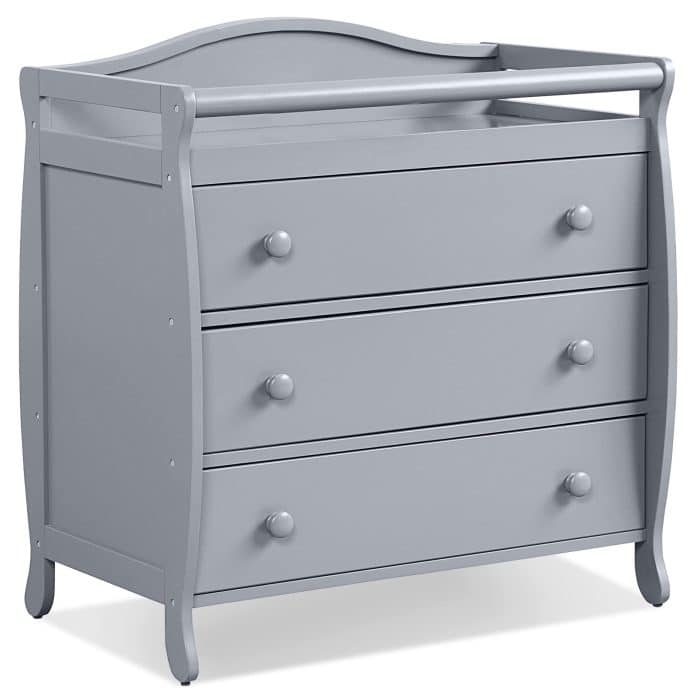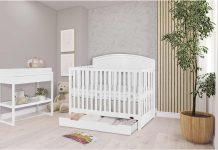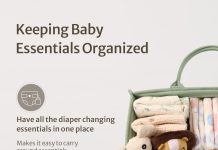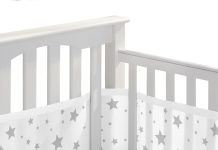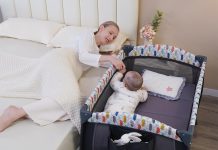In the journey of parenthood, one often finds themselves pondering over the longevity of various baby items. From sleepers to strollers, every decision seems to hold immense importance. But how long does a baby truly need a changing table? With its practicality and convenience, it becomes a staple for many parents. In this article, we will explore the timeline of a changing table’s usefulness, taking into account various factors that come into play as our little ones grow and develop. So, let’s dive into the world of baby-changing tables and uncover the secrets behind their longevity.
Review contents
When should you start using a changing table?
Newborn stage
Using a changing table can start right from birth. Newborns require frequent diaper changes, and having a dedicated space for this task provides convenience and organization. It also helps in creating a diaper changing routine, which can be beneficial in establishing a sense of order and consistency for both parents and the baby.
When the baby starts rolling over
As babies grow, they develop new skills and abilities. One significant milestone is when they start rolling over independently. At this stage, using a changing table becomes crucial to ensure the baby’s safety. Changing tables are designed with raised edges or guardrails to prevent babies from accidentally rolling off and falling. The elevated surface also allows for easy access and maneuverability during diaper changes.
When the baby starts crawling
When babies become mobile and start crawling, a changing table becomes even more essential. Crawling babies can be quick and unpredictable, making diaper changes on the floor or other surfaces challenging. The elevated height of a changing table provides a secure space away from potential hazards, while allowing parents to maintain better control during the changing process.
When the baby is potty trained
Once a baby reaches the stage of being potty trained, the frequency of diaper changes gradually decreases. At this point, using a changing table may not be as necessary. However, it is important to note that accidents can still happen during the potty training phase, so having a designated space for occasional changes can ensure cleanliness and convenience.
Benefits of using a changing table
Convenience and organization
Having a changing table dedicated solely to diaper changes offers a significant level of convenience and organization. All the necessary supplies, such as diapers, wipes, and creams, can be stored within reach, eliminating the need to search for them each time. This not only saves time but also prevents the baby from becoming unsettled during the search for supplies.
Ergonomic height
Changing tables are designed to be at a comfortable height for parents and caregivers. By eliminating the need to bend over or kneel on the floor, using a changing table helps prevent back strain and discomfort. The ergonomic height promotes proper posture, making the diaper changing process more comfortable for the caregiver.
Safety and security
One of the primary benefits of using a changing table is the safety and security it provides for the baby. Changing tables are designed with raised edges or guardrails, ensuring that the baby stays in place during diaper changes. This prevents accidental falls or injuries that can occur when changing the baby on other surfaces. Additionally, some changing tables feature safety straps that keep the baby secure while allowing parents to have both hands free for the changing process.
Diaper changing routine
Using a changing table helps establish a consistent diaper changing routine. Babies thrive on routine and predictability, and regular diaper changes contribute to their overall comfort and well-being. By having a dedicated space for diaper changes, parents can create a calming and familiar environment, reducing any anxiety or resistance the baby may have during the changing process.
Factors to consider when choosing a changing table
Sturdiness and stability
When selecting a changing table, it is crucial to consider its sturdiness and stability. Look for a well-built table made from durable materials that can support the weight of the baby. The table should have a solid and stable base to prevent wobbling or tipping over, ensuring the safety of the baby during diaper changes.
Size and storage capacity
The size of the changing table is an important factor to consider, especially if you have limited space in your nursery or living area. Measure the available space and choose a changing table that fits appropriately without causing any obstructions. Additionally, consider the storage capacity of the table. Look for ample shelving or drawers to accommodate diapering essentials, keeping everything organized and easily accessible.
Safety features
Safety should be a top priority when choosing a changing table. Look for tables with raised edges or guardrails to prevent the baby from rolling off. Some changing tables also feature safety straps that can be secured around the baby’s waist or chest, providing an extra layer of security during the changing process. Make sure these safety features meet or exceed industry standards for infant safety.
Versatility and multi-functionality
Consider the versatility and multi-functionality of the changing table. Some changing tables come with additional features such as detachable changing tops, which can later be converted into a standard dresser or play table as the baby grows. This allows the changing table to serve a dual purpose and provides long-term value for your investment.
Alternative diaper changing stations
Portable changing pads
Portable changing pads offer a convenient and portable solution for changing diapers on the go. These pads are lightweight, compact, and easy to carry in a diaper bag. They provide a clean and comfortable surface for diaper changes on any flat surface, making them suitable for travel or outings.
Changing mats
Changing mats are another alternative to a dedicated changing table. These mats can be placed on any secure surface like a bed or floor. They are usually padded for the baby’s comfort and often come with raised edges to prevent rolling. Changing mats are a space-saving option for parents who prefer a more flexible and versatile diaper changing station.
Changing stations on other furniture
Some parents choose to utilize existing furniture, such as a dresser or chest of drawers, as a makeshift changing station. By adding a changing pad or mat to the top surface of the furniture, it can easily transform into a functional diaper changing area. However, it is crucial to ensure the stability and safety of the furniture used.
Travel-friendly solutions
When traveling or on-the-go, parents can also make use of travel-friendly diaper changing solutions. These may include disposable changing pads or changing kits with built-in storage for essentials. These compact and lightweight options provide a temporary changing space and can be easily packed and carried in a diaper bag.
Transitioning from a changing table
Using the floor or bed
As babies outgrow the need for a changing table, changing diapers can be done directly on the floor or bed. This option offers convenience and flexibility, especially for parents who prefer a more relaxed approach to diaper changes. However, it is important to ensure a safe and clean surface and always stay close to the baby during the changing process.
Utilizing a dresser or chest of drawers
Once the baby is older and less dependent on diaper changes, utilizing a dresser or chest of drawers can be a practical option. By placing a changing pad on top of the furniture, it can serve as a dedicated diaper changing area while also providing additional storage space for clothes, diapers, and other essentials.
Creating a dedicated diaper changing area
For those who prefer maintaining a separate and dedicated diaper changing area, it is possible to create a designated space without using a changing table. This can be accomplished by setting up a changing station on a sturdy countertop or a designated shelf, equipped with all the necessary supplies for diaper changes.
Implementing a diaper changing routine
Regardless of the changing setup, it is important to maintain a consistent diaper changing routine. Babies thrive on predictability, and a routine helps create a sense of security and familiarity. Establish a designated time and place for diaper changes, ensuring that all necessary supplies are readily available.
Signs that your baby is ready to transition
Improved motor skills and coordination
When your baby demonstrates improved motor skills and coordination, such as sitting up unassisted or standing, it may indicate readiness to transition away from a changing table. These milestones suggest that the baby is becoming more independent and capable of handling diaper changes in alternative settings.
Independence in dressing and undressing
If your baby starts showing signs of independence in dressing and undressing, such as attempting to put on clothes or taking off socks, it may indicate readiness to transition from a changing table. This indicates that the baby is developing self-help skills and may no longer require the elevated and controlled environment of a changing table.
Comfort on elevated surfaces
As babies grow, they become more comfortable and confident on elevated surfaces. If your baby shows no signs of anxiety or discomfort when placed on higher surfaces like beds or sofas, it may be a sign that they are ready to transition away from a changing table.
Resistance to lying down
If your baby starts resisting being laid down on a changing table or shows signs of restlessness during diaper changes, it may suggest readiness to transition. Babies communicate their preferences and discomfort through their behavior, and resistance to lying down can be an indication of their readiness for alternative diaper changing setups.
Safety precautions during diaper changes
Always stay with your baby
Regardless of the changing setup, it is important to always stay with your baby during diaper changes. Never leave the baby unattended, even for a moment. Babies can be quick and unpredictable, and accidents can happen in an instant. Staying with your baby ensures their safety and allows you to respond immediately if any issues arise.
Secure the baby on the changing surface
When using a changing table or any other elevated surface, it is essential to secure the baby to prevent accidental falls. Ensure that the safety straps, if provided, are properly fastened around the baby’s waist or chest. Use one hand to hold the baby securely while using the other hand for the diaper change.
Keep all supplies within reach
To minimize the need to leave the baby unattended during diaper changes, it is important to have all the necessary supplies within reach. Prepare everything beforehand and place them within arm’s reach, ensuring that you have easy access to diapers, wipes, creams, and any other items you may need during the diaper change.
Ensure proper hygiene and cleanliness
Maintaining proper hygiene and cleanliness during diaper changes is crucial for the baby’s health and well-being. Always use clean diapers, wipes, and other supplies, and dispose of soiled items in a hygienic manner. Keep the changing area clean and sanitized by wiping down the surface regularly. Proper hygiene practices minimize the risk of infections or irritations for the baby.
Potential risks of using a changing table
Falling off the changing table
One of the most significant risks associated with using a changing table is the baby falling off the elevated surface. This can happen if the baby is left unattended or if the changing table is not sturdy or secure. To prevent falls, always stay with the baby during diaper changes and ensure that the changing table is stable and has appropriate safety features.
Accidental injuries from accessories
Some changing tables come with accessories such as storage compartments or hanging organizers. While these can be useful for organizing supplies, it is important to ensure that any accessories are securely attached and do not pose a risk of falling or causing injuries to the baby. Regularly check for loose or damaged accessories and promptly repair or remove them if necessary.
Inadequate weight capacity
Different changing tables have varying weight capacities. It is essential to choose a changing table that can safely support the weight of the baby. Exceeding the weight limit can compromise the stability and structural integrity of the table, increasing the risk of accidents or injuries. Always check the manufacturer’s guidelines and specifications when selecting a changing table.
Hazards from unsecured items
When using a changing table, it is important to ensure that all items are securely stored and do not pose a risk to the baby. Loose items such as diaper pails, baby powder, or toys should be placed out of reach or securely fastened to prevent accidents or choking hazards. Regularly inspect the changing table area for any potential hazards and remove or address them promptly.
Maintaining and repurposing a changing table
Proper cleaning and sanitization
To maintain hygiene and prolong the life of a changing table, regular cleaning and sanitization are essential. Clean the surface with mild soap and water, thoroughly wiping off any residue to prevent the accumulation of bacteria or germs. Use non-toxic cleaning solutions to ensure the safety of the baby. Additionally, clean and disinfect any accessories or storage compartments attached to the changing table.
Repairing damaged parts
Over time, a changing table may experience wear and tear or minor damages. Promptly address any damaged parts to ensure the safety and functionality of the table. Repair loose guardrails, hinges, or drawers to maintain the stability and durability of the changing table. Consult the manufacturer’s instructions or seek professional assistance if needed.
Transforming into a storage unit
If you no longer require a changing table, consider repurposing it as a storage unit. Remove the changing pad or top tray and use the table as a dresser or shelving unit for your baby’s clothes, toys, or other essentials. This allows you to maximize the use of the furniture while still maintaining its functionality in the nursery or any other room.
Passing it down or selling
If you wish to part ways with the changing table, consider passing it down to another family member or friend who may benefit from it. Alternatively, you can sell the changing table or donate it to a local charity or organization. Properly clean and disinfect the table before passing it down or selling, ensuring that it is in good condition and safe to use.
Final thoughts on the longevity of changing tables
Changing tables provide a dedicated and convenient space for diaper changes, offering numerous benefits in terms of organization, ergonomics, safety, and routine. The duration of using a changing table varies depending on the baby’s developmental milestones and readiness for alternative diaper changing setups. As your baby grows and becomes more independent, transitioning away from a changing table can be a natural progression. Regardless of the chosen diaper changing setup, proper safety precautions, hygiene practices, and attention to the baby’s needs should always be prioritized to ensure a smooth and secure diaper changing experience.

